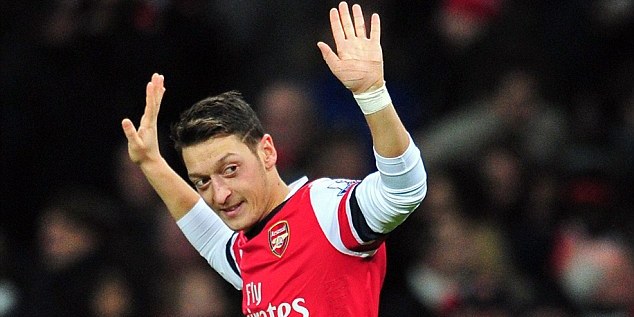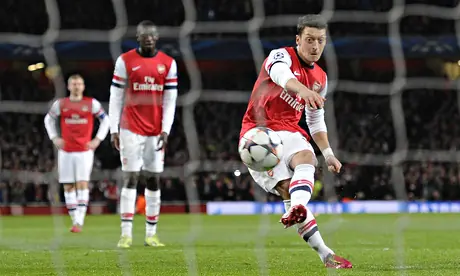But it’s (probably) all in the eyes
For the second time in the Champions League this season Mesut Ozil failed to score from the penalty spot, making it a hat-trick of misses for the German international.
During the group stage of the competition Ozil had the chance to double his teams lead against Marseille, but having taken an age with his one-step run up (sound familiar?), keeper Steve Mandanda palmed away a weak spot kick from Arsenal’s no.11.
In his three years at Real Madrid the playmaker was never required to take a penalty, but rewinding to 2009 the twenty year old’s failure to convert for Werder Bremen in the Bundesliga against Borussia Monchengladbach was dismissed as the team finished tenth and he completed his season with a respectable three goals and fifteen assists.
Arsenal manager Arsene Wenger left Ozil out of the squad for Premier League game against Sunderland this weekend, having openly criticised his record signing for having poor form and a casual approach to penalty taking. Little does he know that this is the best way to deal with the pressure of penalty taking, as long as he can control his eyes.
The first sports psychology laboratory was created in Berlin by fellow German Dr Carl Diem in the early 1920’s, almost a century later and we’re still measuring physical ability and aptitude in sport. Studies produced on behalf of the British Association of Sports and Exercise Sciences have discovered several behavioural cues likely to occur in high anxiety situations, giving insight into the minds of the players when faced with the pressure of taking a spot kick.
Those watching the mid-week game would have seen Özil pace backwards from placing the ball on the penalty spot, patiently waiting for referee Nicola Rizzoli to signal before taking his shot. This so called ‘casual approach’ is the best way to prepare for a penalty kick as it suggests the player is less stressed than your typical ‘hidden and hasty’ penalty takers who will turn away from the goal (and from their responsibility) before rushing to have the ordeal over and done with.
By facing the goal throughout, Ozil was successfully covering his anxieties, having been such a high profile signing at the club with status and expectation on his shoulders, appearing threatened by international teammate Manuel Neuer was not an option.
Having been blasted for not applauding travelling fans towards the end of 2013, as well as his recent poor form, Ozil could not be blamed for any distress he felt in having the responsibility of putting Arsenal in the lead at the Emirates. While appearing patient, Ozil’s gaze did not leave Rizzoli as he awaited permission to take the penalty, the short length of time from the ref’s signal to his run up suggests he was eager to finish the job(ignoring the one-step run up, arguably a style but in my opinion an inability to control his lack of confidence) at the expense of accuracy and sufficient pace which could have seen the shot resulting in a goal.
In trying not to leak intentions, players often face a trade-off between what they should be looking at, and what they’re trying not to look at. If the eyes of the player are focussed centrally, the shot will become centralized, much like focussing on the horizon when driving a car will ensure you stay on the road, it would appear to be common sense to aim where you are looking, but football players demonstrate a suboptimal strategy whereby they relinquish control and focus on trying to fool the opponent into diving the wrong way.
A day prior to Ozil’s miss, Lionel Messi dispatched the spot kick straight down the middle and past Joe Hart. Having watched both penalties a number of times, I can’t say I felt a significant difference in the amount of power driven through the ball, what I did notice however was a confident run up from the four time Ballon d’Or winner and an early dive from the keeper towards the Argentine’s most visited side of the net. Both of these factors are undeniably important, but what’s more is Joe Hart’s lack of presence.
The perceived size of the goalkeeper based on their presence between the posts disrupts a players optimal attentional outlook, for Özil this would have been inflated as he was facing a keeper he’d played alongside at Shalke 04 for two years and for Germany from 2009. Watching the penalty from a goal facing angle, my attention is automatically drawn to Neuer bouncing on his toes and covering the space around him – studies show that anxious players are easier distracted by movements as their gaze is disrupted, leading to more shots being fired into centralised locations.
On tracking the eye movements of goalkeepers, they are more interested in the movements of the opponents legs and hips, therefore the eye gaze of the player will rarely influence them to remain central of the goal, but merely allow them to position themselves so as to cover as much of the central area – as shown by Neuer’s ability to stop Ozil’s shot with his arm alone.
There is no denying that Mesut Ozil oozes class, in his last three seasons before joining Arsenal he amassed an impressive 94 assists for club and country, but should he ever be called upon to take another penalty, a target focussed strategy should prove more effective. His eyes should provide his brain with the necessary visual information for accurate shooting and he should remain in control of the situation, overcoming the anxieties which have previously led him to rush the penalty and fail as a consequence. Contracted at Arsenal until 2018, for a weekly salary in the region of £130,000 a week, I’d say keeping his head high and eyes in front of him is the least he can do.
Add Sportslens to your Google News Feed!

